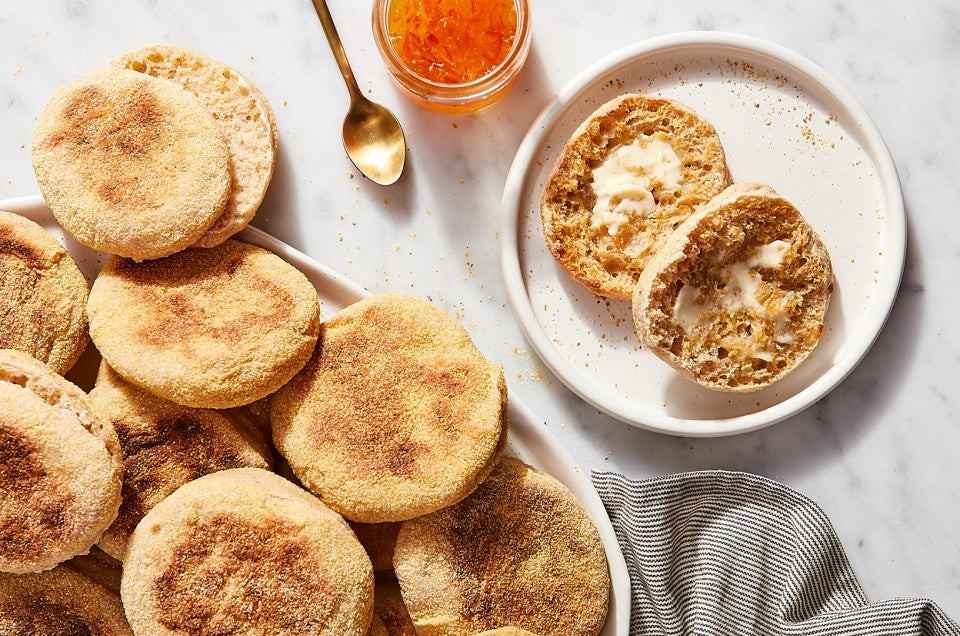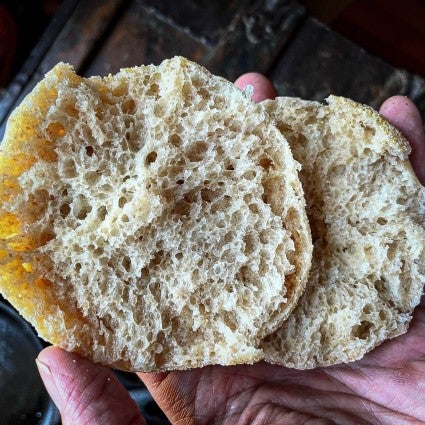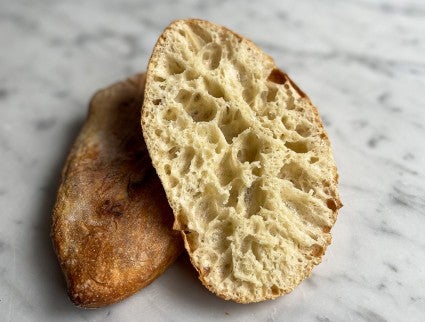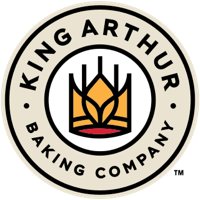


 At our house, store-bought bread is like a cedar waxwing. It swoops past in springtime and might be seen in the fall, but for the most part it’s a rare bird. And that’s OK. With me around, baking all the time, we have our own flock of loaves: a chestnut miche, a Japanese milk bread, even crackling baguettes. But occasionally one can glimpse a plastic package on the roost ... we have a weakness for English muffins.
At our house, store-bought bread is like a cedar waxwing. It swoops past in springtime and might be seen in the fall, but for the most part it’s a rare bird. And that’s OK. With me around, baking all the time, we have our own flock of loaves: a chestnut miche, a Japanese milk bread, even crackling baguettes. But occasionally one can glimpse a plastic package on the roost ... we have a weakness for English muffins.
Toothy and tender with a little acidity and a crunchy crispiness after a good toasting — let’s agree, English muffins are irresistible. And that’s enough to get me in the kitchen. I love a challenge and I love to bake — what would it take to make a great version myself?
After some searching and a survey of recipes, I get a sense of ratios for the main ingredients (flour and water) and assess common methods. I also think about my idea of a perfect English muffin.
Here’s what I want to achieve with my own version:
With these hopes in hand, I find a basic recipe and set off.
Test one: all-purpose flour, a little sourdough culture, quite a bit of yeast, and a relatively short process.

Feeling like nothing really worked, I decide to head in a completely different direction and write my own recipe.
1. First challenge, fix the crannies
Knowing the hardest part will be the crannies, that’s where I begin. Thinking through my toolbox of methods and doughs that produce a more open structure, I consider a dinner roll I’d recently made using our simple recipe, Unkneaded Six-Fold French Bread. It had yielded an excellent open crumb.

I’m confident some aspects of the six-fold dough will translate well to the muffin. Here’s why.
A dough that is over-fermented (with too much yeast) will often have a structure with many, many small holes. I blame overactivity for the fine-textured first test. With a little less activity (less yeast) and slightly wetter dough, I'm confident that the structure will be open (similar to the roll above).
So my first change is to slow down the fermentation to improve structure. I don’t try to fix flavor or texture with this test — I’m just working on the holes.
It works. The first test looks good. We have crannies.

But the flavor and texture need work.
2. Next step, flavor
To get brightness and slight acidity, sourdough culture is an obvious choice. I could also consider vinegar, but before going that route I’ll see what I can achieve with sourdough. Sourdough culture produces acetic acid as a byproduct of fermentation — it may be enough. I make a preferment with a little whole-grain flour to encourage flavor production and add an overnight cold rest for an additional boost of flavor and strength. With these changes, I'm ready for the next round of testing.
The sourdough works, maybe even a little too well. The initial test is too acidic, but after a few more rounds I find the sweet spot. The result is bright flavor with good crannies. Onward to texture.
3. Last, the texture
This should be an easy one. Rather than semolina on the outside, I choose cornmeal. Coarser than semolina, it will add crunch — plus it's pretty and toasts well. For an additional boost of texture, I also toast some cornmeal and add it to the dough itself. So, toasted cornmeal inside and some on the outside too: flavor and crunch.

Finally, I combine it all.
After a couple more tests to get the sizing and method ironed out, I feel like I’m ready to move on. The goals I brought to the recipe — gaping nooks and crannies, bright flavor that can hold its own against rich toppings, and a nutty, toasted texture — have me close to satisfied. And if that’s not reason enough to wrap this up, our freezer is overflowing with English muffins (maybe that’s what I’ll use for stuffing bread ... ).
I love these cut 3 1/2” in diameter, and I like them bigger, too (4”), as they make a great egg sandwich or burger bun. I also recommend cutting squares to avoid the whole issue of scrap dough and re-rolling (which hurts the structure). Look for instructions in the "tips" at the bottom of the Artisan English Muffin recipe page for details.
While wrapping up this blog, I watched a flock of waxwings dive into our apple tree. As they fed on what remains of this year's fruit, hurrying to outrun the shortening days and winter, they got me thinking: what do any of us need to reach spring? What will ease the journey until leaves return; until snow melts; until the crabapple lights blossom fireworks and my chill recedes?
I need holidays. I need family and friends and seasonal rituals. I need faces around the wood stove with warmth in bowls. And I need sunny, fork-split English muffin rounds, hot off the griddle. Keep going, friends. Let's bake it 'til we make it. See you in March.
Cover image by Rick Holbrook.


November 10, 2024 at 5:31pm
I would like to try these without the commercial yeast. Would I simply omit the yeast or should I also increase the amount of sourdough starter? If I should increase the starter, how much?
Thanks
November 17, 2024 at 9:47am
In reply to I would like to try these… by Shari (not verified)
Hi Shari, I think it would work fine to omit the yeast in this recipe and simply allow the dough a bit more time to rise. Timing the recipe just right so that you still get those nooks and crannies will likely be the major challenge, but they'll still be delicious!
October 29, 2023 at 10:53am
Would this translate into an English Muffin bread? I'm trying to find one with good nooks and crannies.
October 29, 2023 at 2:33pm
In reply to Would this translate into an… by Patricia Hans (not verified)
Hi Patricia, the nooks and crannies may not translate well to a full loaf because the weight of the dough tends to compact the structure in a larger loaf. However, we're big fans of this English Muffin Toasting Bread recipe.
April 6, 2023 at 9:46am
Is there a way to use this recipe without the sour dough starter? I really don’t want the responsibility and pressure of maintaining a starter. It’s like adopting a small child or puppy.
April 6, 2023 at 2:25pm
In reply to Is there a way to use this… by Karen (not verified)
Hi Karen, this recipe is leavened with the sourdough starter so it is a pretty important part of this recipe. I would recommend trying out this Baked English Muffin Recipe!
March 4, 2022 at 10:39am
Thank you for this timely information as I recently started my own sourdough starter and as I’m not happy with any of the English muffin recipes I’ve tried over the years I’ve been thinking about how I could make an artisan English muffin. Artisan bread is my favorite bread and I love English muffins so I’m looking forward making these! Thank you!
March 8, 2022 at 12:29pm
In reply to Thank you for this timely… by SueMN (not verified)
I made these today and they are excellent! The nooks and crannies are not as pronounced as yours but much better than the bread-like English Muffin recipes I’ve previously used. They’re best when toasted and topped with peanut butter/jelly or made into an egg sandwich!
December 6, 2021 at 7:45am
Made these yesterday. The “nooks and crannies” are there, all right. But there are two things that I think could be better: the thickness, and the flavor. I was very careful in handling the dough, so as not to deflate it, but the muffins were thinner than I wanted. The flavor: just okay. I wonder if you could substitute some of the water in the recipe with buttermilk?
December 8, 2021 at 6:20pm
In reply to Made these yesterday. The … by Ellen Moloney (not verified)
You certainly could make this substitution, Ellen, with a 1:1 swap of water for buttermilk. The result will be a more rich and tangy English muffin. Happy baking!
Pagination